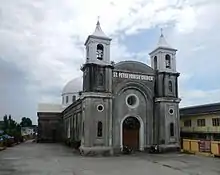San Pedro Apostol Church (Apalit)
Apalit Church is a Neo-Renaissance-style church located at Apalit, in the province of Pampanga, Philippines. The additional construction of the two towers beside the church served as reinforcements to improve the structural integrity of the church. Also, the church houses bells manufactured by the Sunicos.
| Apalit Church | |
|---|---|
| San Pedro Apostol Parish Church | |
 Facade of the San Pedro Apostol Church in Pampanga | |
.svg.png.webp) Apalit Church Location in the Philippines | |
| 14°57′13″N 120°46′21″E | |
| Location | Apalit, Pampanga |
| Country | |
| Denomination | Roman Catholic |
| History | |
| Status | Parish church |
| Architecture | |
| Functional status | Active |
| Architectural type | Church building |
| Administration | |
| Archdiocese | San Fernando |
| Clergy | |
| Archbishop | Florentino Lavarias |
| Priest(s) | Rev. Msgr. Antonio M. Bustos |
History
In 1597, the Parish of Apalit was separated from the Parish of Calumpit. Fr. Pedro de Vergara was installed as the first curé of Apalit.
On June 28, 1844, the traditional fluvial procession called Libad honouring Saint Peter the Apostle was instituted by Capitán del Pueblo Don Pedro Armayan Espíritu.[1]
On July 22, 2017, the holy relic of St. Peter was enthroned in the Parish. The holy relic is a fragment of the bones of the remains of St. Peter. This is the only church that has the relic of St. Peter other than St. Peter's Basilica in Rome.
Architectural history
Fr. Simón de Alarcia
- From 1854 to 1860, he tried to build a three-nave church using stone and brick materials. However, records do not indicate if he was able to finish the church.[2]
- 1863: the church is destroyed in an earthquake that damaged buildings in Manila.[2]
Fr. Antonio Redondo
Fr. Toribio Fanjul
- The two belltowers were completed in 1896.[1]
Msgr. Rústico C. Cuevas
- 1989: Major renovations were conducted at the church.[1]
Architectural features
Apalit Church measures 59 meters long and 14 meters wide. The facade resembles Neo-Renaissance Style with its plain, low segmental pediment and the symmetrical alignment of 2 flanking towers. The semi-circular main door with a circular window above is framed by receding semicircular arches in relief.[2]
The ceiling art paintings, also known as trompe l'oeil were done by a native of Apalit, under the supervision of Caesare Alberoni, an Italian free-lance painter. One notable ceiling art paintings was located in the cupola of the Apalit Church, giving a rendition of the Apocalypse.[4]
There are 6 bells located at the Apalit Church, 5 of which came from Fundicion de Hilario Sunico Jaboneros.[4]
Below were the list of the bells with corresponding inscriptions:
| Left northeastern tower | Weight (in lb.) | Inscription |
|---|---|---|
| Smallest bell | 1/2 lb. | AÑO 1895-5 @ (ARROBAS) |
| Front, cracked | 3 lbs. | SAGRADO CORAZON DE MARIA-SIENDO CURA PARROCO EL M.R.P. FR. TORIBIO FANJUL AÑO 1896 31 |
| Second largest bell center stationary | 8 lb. | S. PEDRO Y S. PABLO-FVNDIOSE ESTA CAMPANA EL AÑO DE 1821 SIENDO CVRA DE APALIT EL R.P.DIF.r F. JOSEPH POMETA AL TRIDECIMO AÑO DE CURA DE DICHO PUEBLO-FECIT BENITVS a REGIBUS-44 |
| Right southeastern tower | Weight (in lb.) | Inscription |
| Second smallest bell, clapperless | - | SAN PEDRO DONACION DE D.a SABINA SIOCO-SIENDO CURA PARROCO EL REV. P. ANDRES BITUIN-APALIT, PAMPANGA. AÑO 1931-61 kilos |
| Big, clapperless bell (made outside of wrought metal bearing) | 6 lbs. | * hardly-legible inscription |
| Front, biggest bell, chipped | 10 lbs. | SAGRADO CORAZON DE JESUS-SIENDO CURA PARROCO EL M.R.P.F. TORIBIO FANJUL AÑO 1896-44 |
Present condition
Marker from the National Historical Commission of the Philippines
The marker of Church of Apalit was installed in 1939 at Apalit, Pampanga. It was installed by Philippines Historical Committee (now National Historical Commission of the Philippines).[5]
| Church of Apalit |
|---|
| DATES FROM 1590. THE FORMER CHURCH, BUILT OF BRICK, WAS DESTROYED BY THE EARTHQUAKE OF 1863. THE PRESENT CHURCH WAS CONSTRUCTED BY MARIANO SANTOS, OF GUAGUA, UNDER THE SUPERVISION OF THE REV. ANTONIO REDONDO, O.S.A., BETWEEN 1876 AND 1880. ITS TOWERS WERE FINISHED IN 1896 BY THE REV. TORIBIO FANJUL, WHO PURPOSELY MADE THEM LOW TO MINIMIZE THE EFFECTS OF EARTHQUAKES.[5] |
Gallery
 Inside the cathedral
Inside the cathedral Aisle
Aisle Looking to main altar
Looking to main altar View from main altar to front
View from main altar to front The dome
The dome Details on the ceiling of the church
Details on the ceiling of the church The pulpit
The pulpit
References
| Wikimedia Commons has media related to San Pedro Apostol Church, Apalit. |
- "Man-made attraction, Apalit St. Peter Shrine". November 1, 2014.
- Alarcon, Norma (2008). Philippine architecture during the pre-Spanish and Spanish periods. UST Publishing House.
- Galende, Pedro G. (1987). Angels in Stone: Architecture of Augustinian Churches in the Philippines. G. A. Formoso Publishing.
- "ING PARROQUIA NING APALIT". November 1, 2014.
- Historical Markers: Metropolitan Manila. National Historical Institute. 1993.